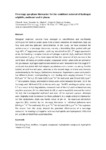Mostrar o rexistro simple do ítem
Two‐stage gas‐phase bioreactor for the combined removal of hydrogen sulphide, methanol and α‐pinene
| dc.contributor.author | Rene, Eldon R. | |
| dc.contributor.author | Jin, Yaomin | |
| dc.contributor.author | Veiga, María Carmen | |
| dc.contributor.author | Kennes, Christian | |
| dc.date.accessioned | 2014-10-30T12:41:08Z | |
| dc.date.available | 2014-10-30T12:41:08Z | |
| dc.date.issued | 2009 | |
| dc.identifier.citation | Rene ER, Jin Y, Veiga MC, Kennes C. Two-stage gas-phase bioreactor for the combined removal of hydrogen sulphide, methanol and -pinene. Environ Technol. 2009;30(12):1261- 72 | es_ES |
| dc.identifier.other | DOI: 10.1080/09593330903196868 | |
| dc.identifier.uri | http://hdl.handle.net/2183/13753 | |
| dc.description.abstract | Biological treatment systems have emerged as cost‐effective and eco‐friendly techniques for treating waste gases from process industries at moderately high gas flow rates and low pollutant concentrations. In this study, we have assessed the performance of a two‐stage bioreactor, namely a biotrickling filter packed with pall rings (BTF, 1st stage) and a perlite + pall ring mixed biofilter (BF, 2nd stage) operated in series, for handling a complex mixture of hydrogen sulphide (H2S), methanol (CH3OH) and α‐pinene (C10H16). It has been reported that the presence of H2S can reduce the biofiltration efficiency of volatile organic compounds (VOCs) when both are present in the gas mixture. Hydrogen sulphide and methanol were removed in the first stage BTF, previously inoculated with H2S‐adapted populations and a culture containing Candida boidinii, an acid‐tolerant yeast, whereas, in the second stage, α‐pinene was removed predominantly by the fungus Ophiostoma stenoceras. Experiments were conducted in five different phases, corresponding to inlet loading rates varying between 2.1 and 93.5 g m−3 h−1 for H2S, 55.3 and 1260.2 g m−3 h−1 for methanol, and 2.8 and 161.1 g m−3 h−1 for α‐pinene. Empty bed residence times were varied between 83.4 and 10 s in the first stage and 146.4 and 17.6 s in the second stage. The BTF, working at a pH as low as 2.7 as a result of H2S degradation, removed most of the H2S and methanol but only very little α‐pinene. On the other hand, the BF, at a pH around 6.0, removed the rest of the H2S, the non‐degraded methanol and most of the α‐pinene vapours. Attempts were originally made to remove the three pollutants in a single acidophilic bioreactor, but the Ophiostoma strain was hardly active at pH <4. The maximum elimination capacities (ECs) reached by the two‐stage bioreactor for individual pollutants were 894.4 g m−3 h−1 for methanol, 45.1 g m−3 h−1 for H2S and 138.1 g m−3 h–1 for α‐pinene. The results from this study showed the potential effectiveness of a two‐stage bioreactor for treating H2S together with two hydrophilic and hydrophobic VOCs that are typically emitted from wood industries. | es_ES |
| dc.language.iso | eng | es_ES |
| dc.publisher | Taylor & Francis | es_ES |
| dc.relation.uri | http://dx.doi.org/10.1080/09593330903196868 | es_ES |
| dc.rights | This is an Accepted Manuscript of an article published by Taylor & Francis Group in Environmental Technology on November 2009, available online at: http://www.tandfonline.com/10.1080/09593330903196868 | es_ES |
| dc.subject | Biotrickling filter | es_ES |
| dc.subject | Biofilter | es_ES |
| dc.subject | Inorganic compound | es_ES |
| dc.subject | Hydrophobic compound | es_ES |
| dc.subject | Hydrophilic compound | es_ES |
| dc.subject | Fungi | es_ES |
| dc.title | Two‐stage gas‐phase bioreactor for the combined removal of hydrogen sulphide, methanol and α‐pinene | es_ES |
| dc.type | info:eu-repo/semantics/article | es_ES |
| dc.rights.access | info:eu-repo/semantics/openAccess | es_ES |
Ficheiros no ítem
Este ítem aparece na(s) seguinte(s) colección(s)
-
GI-BIOENGIN- Artigos [91]






